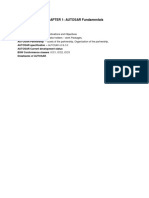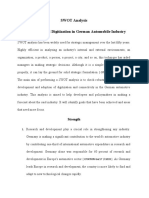Autosar Brochure en
Autosar Brochure en
Uploaded by
Miha_BucurestiCopyright:
Available Formats
Autosar Brochure en
Autosar Brochure en
Uploaded by
Miha_BucurestiOriginal Title
Copyright
Available Formats
Share this document
Did you find this document useful?
Is this content inappropriate?
Copyright:
Available Formats
Autosar Brochure en
Autosar Brochure en
Uploaded by
Miha_BucurestiCopyright:
Available Formats
AUTOSAR The Worldwide Automotive Standard for E/E Systems
Enabling Innovation
AUTOSAR (AUTomotive Open System ARchitecture) is a partnership between automotive manufacturers, suppliers and tool and semiconductor vendors. Since 2003 AUTOSAR has been working on the development of an open, standardized software architecture for automotive electronic control units (ECUs).
Principle of AUTOSAR
AUTOSAR has the principle Cooperate on standards, compete on implementation. As the delivery of implementations in particular implementations of basic software and tooling must be enabled and supported worldwide, the best quality and service is expected in free competition on implementation level.
The AUTOSAR development partnership is focused on managing the growing complexity in the development of automotive electric/electronic (E/E) architecture, with the aim to improve development efficiency without making compromises on quality. AUTOSAR paves the way for innovative electronic systems that further improve performance, safety and environmental friendliness.
AUTOSAR The Idea The AUTOSAR standard consists of a set of specifications that describe a software architecture, application interfaces and a methodology. The AUTOSAR layered software architecture enables the development of independent software components. These can be used in vehicles of different manufacturers, and in electronic components of different suppliers that can
span multiple product generations. It results in a high reliability of the overall system with significant cost and capacity benefits. The AUTOSAR principle Cooperate on standards, compete on implementation offers various benefits to automotive manufacturers, automotive suppliers, tool providers, and even new market entrants.
Autosar The Vision
AUTOSAR aims to improve complexity management of integrated E/E architectures through increased reuse and transferability of SW modules between OEMs and suppliers.
AUTOSAR Key Milestones Phase I (2003-2006) AUTOSAR was founded as a development partnership in 2003 Release 1.0: AUTOSAR specifications for basic software below the runtime environment (RTE) level Release 2.0 and 2.1: completion of Basic Software (BSW) components and the RTE With Release 2.1 and Release 3.0/3.1, the majority of members started their series roll-out of AUTOSAR Phase II (2007-2009) Release 3.0: harmonization of the ECU wake-up and the network start-up Release 3.1: incorporation of OnBoard-Diagnostics (OBD) regulations support mechanisms First ECUs based on AUTOSAR have entered production in 2008 Release 4.0: new features for functional safety and communication Work on new car domains in the field of application interfaces: Telematics/ Multimedia/HMI and Occupants and Pedestrian Safety Systems Phase III (2010-2012) Release 3.2.1 and 4.0.3: incorporation of Partial Networking General Objectives: Maintenance of existing releases Selective enhancement of the standard driven by market needs Improve maintainability of the standard Post phase III (from 2013 onwards) Selective, market-driven enhancements and extensions to the standard with focus on stabilization, limited number of parallel Releases and excellent match of series development requirements Release 4.1 Revision 1 (planned to be published in March 2013): AUTOSAR will introduce about 30 new concepts for enhanced functionality and maintainability, usability and compliance Enhanced features for new technologies like multi-core processors, Ethernet/TCP/IP communication mechanisms and others
Benefits of Autosar The realization of the AUTOSAR industry standard will provide significant benefits for OEMs, suppliers, semiconductor vendors as well as for tool and service providers and new market entrants. BENefits for OEM: Establish development distribution among suppliers Compete on innovative functions with increased design flexibility Simplify software and system integration Reduce overall software development costs Benefits for tool provider: Tool based development process and standardized exchange formats Benefits for supplier: Reduce implementation variability using an industry wide standard Reuse software modules across OEMs Increase efficiency of application development Invent new business models
Benefits for new market entrant: Enable new business models by means of standardized interfaces
AUTOSAR The Global Automotive Software Standard
Many OEMs and suppliers rely on the standard and are introducing AUTOSAR in a wide range of applications. 25 million ECUs produced by the AUTOSAR Core Partners in 2011 are based on the AUTOSAR architecture, with 300 million planned for 2016.
Enabling Innovation
How to become an AUTOSAR member: For further information please visit www.autosar.org Send an e-mail to request@autosar.org to receive the AUTOSAR information package. Become a member and avail exploitation rights for the AUTOSAR Standard.
Members of the AUTOSAR Development Partnership (Status: December 2011)
The AUTOSAR development partnership reserves all rights even in the event of industrial rights. We reserve all rights of disposal such as copying and passing on third parties.
Enabling Innovation
You might also like
- 2-10 Automotive-Spice Version 3 PocketguideDocument110 pages2-10 Automotive-Spice Version 3 PocketguideMarwen BoualleguiNo ratings yet
- 07.TAI Seminar WHAT Is FUNCTIONAL SAFETY BKK 25june2015 HandsoutDocument33 pages07.TAI Seminar WHAT Is FUNCTIONAL SAFETY BKK 25june2015 HandsoutsunithaNo ratings yet
- Microautobox II DspaceDocument24 pagesMicroautobox II DspacehieuhuechchNo ratings yet
- Laboratory No. 1 - Introduction To SOLIDWORKSDocument14 pagesLaboratory No. 1 - Introduction To SOLIDWORKSyahhNo ratings yet
- CHAPTER 1: AUTOSAR Fundamentals Topics CoveredDocument14 pagesCHAPTER 1: AUTOSAR Fundamentals Topics CoveredSujit KumarNo ratings yet
- Design Process Hardware Autosar: Present Problems The Autosar StandardDocument3 pagesDesign Process Hardware Autosar: Present Problems The Autosar StandardJnsk SrinuNo ratings yet
- Autosar IntroDocument54 pagesAutosar IntroaravindNo ratings yet
- Static Analysis of Software: The Abstract InterpretationFrom EverandStatic Analysis of Software: The Abstract InterpretationNo ratings yet
- Welcome To AUTOSAR Builder 2023xDocument19 pagesWelcome To AUTOSAR Builder 2023xVeeresh AmbeNo ratings yet
- Autosar Sws DiagnosticoveripDocument127 pagesAutosar Sws DiagnosticoveripStefan RuscanuNo ratings yet
- CAN Configuration Within AutosarDocument6 pagesCAN Configuration Within Autosarmail87523No ratings yet
- Eth AutosarDocument61 pagesEth AutosarMAHESH VNo ratings yet
- T-Dplat, TATA ELXSI Diagnostics Platform: Prem Mohan Nair & Sreeraj ADocument5 pagesT-Dplat, TATA ELXSI Diagnostics Platform: Prem Mohan Nair & Sreeraj Acoolman729No ratings yet
- Autosar Secoc For Can FDDocument2 pagesAutosar Secoc For Can FDgptgNo ratings yet
- I 14229Document17 pagesI 14229krishnaNo ratings yet
- Unit 4 SystemDesk 4Document10 pagesUnit 4 SystemDesk 4Farwa ZahidNo ratings yet
- Autosar TR IntegrationintommthmiecuDocument37 pagesAutosar TR Integrationintommthmiecuestraj1954No ratings yet
- AUTOSAR EXP ErrorDescriptionDocument79 pagesAUTOSAR EXP ErrorDescriptionTan HuynhNo ratings yet
- Functional Safety Management Aspects in Testing of Automotive Safety Concern SystemsDocument4 pagesFunctional Safety Management Aspects in Testing of Automotive Safety Concern SystemssnehanagendraNo ratings yet
- Technologiebroschuere E-Drives 2013-07-130913 EbookDocument60 pagesTechnologiebroschuere E-Drives 2013-07-130913 EbookSertug BaşarNo ratings yet
- Uds ImpDocument6 pagesUds ImppriyaNo ratings yet
- Cybersecurity in AutomotiveDocument3 pagesCybersecurity in AutomotiveDebasish BanerjeeNo ratings yet
- Agile in Automotive - State of Practice 2015Document72 pagesAgile in Automotive - State of Practice 2015GhaziElKhamsaNo ratings yet
- Autosar Srs RteDocument86 pagesAutosar Srs RteZozo94No ratings yet
- Autosar Exp NvdatahandlingDocument51 pagesAutosar Exp NvdatahandlingSugadevNo ratings yet
- AUTOSAR SWS SPIHandlerDriverDocument98 pagesAUTOSAR SWS SPIHandlerDriverjaandu0% (1)
- 1.vehicle OverviewDocument34 pages1.vehicle OverviewShashikumar ChanchiNo ratings yet
- ASPICE 6 Ver - 1Document4 pagesASPICE 6 Ver - 1raghunayagan PNo ratings yet
- KPIT PresentationDocument18 pagesKPIT PresentationAmitkumar GundadNo ratings yet
- Ramu Resume IVI Test EngineerDocument2 pagesRamu Resume IVI Test EngineerSatyajit ShaooNo ratings yet
- Function and Software Development For Ecus: Cover StoryDocument6 pagesFunction and Software Development For Ecus: Cover StorypetrishiaNo ratings yet
- Autosar Prs SomeipprotocolDocument50 pagesAutosar Prs Someipprotocolsurya jeevagandanNo ratings yet
- Introduction To HIL Simulation - 2Document12 pagesIntroduction To HIL Simulation - 2Kavuri Sai PradeepNo ratings yet
- Asam Sovd BS V1-0Document14 pagesAsam Sovd BS V1-0TwinNo ratings yet
- AUTOSAR Using EB TresosDocument6 pagesAUTOSAR Using EB Tresosjacob haNo ratings yet
- Ds2211 Hil Io Board Dspace Catalog 2008Document6 pagesDs2211 Hil Io Board Dspace Catalog 2008Ram Krishan SharmaNo ratings yet
- Autosar RTE LayerDocument1,116 pagesAutosar RTE LayerChethanNo ratings yet
- AUTOSAR FO PRS SecOcProtocolDocument29 pagesAUTOSAR FO PRS SecOcProtocolChaos XiaNo ratings yet
- Mab Control Algorithm Modeling Guidelines Using Matlab Simulink and Stateflow v5Document272 pagesMab Control Algorithm Modeling Guidelines Using Matlab Simulink and Stateflow v5ganeshNo ratings yet
- Towards A Security Driven Automotive Development LifecycleDocument22 pagesTowards A Security Driven Automotive Development LifecycleRaviNo ratings yet
- Autosar PPTDocument10 pagesAutosar PPTRahul Wali100% (1)
- Advanced Driver Assistance (ADAS) Solutions GuideDocument29 pagesAdvanced Driver Assistance (ADAS) Solutions GuideDharmody0% (1)
- dSPACENews2006-3 AutomationDesk en Pn422Document2 pagesdSPACENews2006-3 AutomationDesk en Pn422TYu4443No ratings yet
- Wipro PowerpointDocument26 pagesWipro PowerpointBhaveen JoshiNo ratings yet
- User'S Design Specification For Vessel: TAG NO. PHEL-U2-DB-02 UDS NO: PHEL-182001-UDS-0DB-02 Rev 0Document1 pageUser'S Design Specification For Vessel: TAG NO. PHEL-U2-DB-02 UDS NO: PHEL-182001-UDS-0DB-02 Rev 0shazanNo ratings yet
- AUTOSARDocument187 pagesAUTOSARshankarNo ratings yet
- The Connected Car Revolution Is Happening Out of India For The Globe - Why We Need To Seize The MomentDocument8 pagesThe Connected Car Revolution Is Happening Out of India For The Globe - Why We Need To Seize The MomentMilind ShendurnikarNo ratings yet
- Dspace-Paper Hil Overview Waeltermann e 160405 PDFDocument14 pagesDspace-Paper Hil Overview Waeltermann e 160405 PDFPranay VermaNo ratings yet
- Automatic Simulation Measurement and Verification of Inputs and Outputs of Body Control ModuleDocument4 pagesAutomatic Simulation Measurement and Verification of Inputs and Outputs of Body Control ModuleInternational Journal of Innovative Science and Research TechnologyNo ratings yet
- The TCP/IP ProtocolDocument39 pagesThe TCP/IP ProtocolAsfikRahmanNo ratings yet
- SecOC PresentationDocument32 pagesSecOC PresentationSrikanth Reddy100% (1)
- SWOT AnalysisDocument13 pagesSWOT AnalysisOzair ShaukatNo ratings yet
- Exploring Automotive Embedded Systems and Their Applications - Skill-Lync BlogsDocument10 pagesExploring Automotive Embedded Systems and Their Applications - Skill-Lync Blogslakshmivs23No ratings yet
- Aspice 6Document7 pagesAspice 6raghunayagan PNo ratings yet
- 4-14 - p18 - Tips-And-Tricks-For-The-Use-Of-Capl-Part 3 - Lobmeyer - MarktlDocument4 pages4-14 - p18 - Tips-And-Tricks-For-The-Use-Of-Capl-Part 3 - Lobmeyer - MarktlMohammad FaizanNo ratings yet
- Hardware in Loop SimulationDocument12 pagesHardware in Loop Simulationmullig86No ratings yet
- CAPL 3 CANNewsletter 201411 PressArticle enDocument2 pagesCAPL 3 CANNewsletter 201411 PressArticle endaourdiopNo ratings yet
- Advanced Driver Assistance Systems (ADAS) Standard RequirementsFrom EverandAdvanced Driver Assistance Systems (ADAS) Standard RequirementsNo ratings yet
- Visual Studio Code: Eclipse Demo Camp, Zürich 2018Document13 pagesVisual Studio Code: Eclipse Demo Camp, Zürich 2018OnitraNo ratings yet
- Q.1 (A) Give Full Form of Following AcronymDocument16 pagesQ.1 (A) Give Full Form of Following AcronymsvNo ratings yet
- Anr 3.1.7 (30170252) 20230207 233058 1611174316Document11 pagesAnr 3.1.7 (30170252) 20230207 233058 1611174316ZERWIN ANDANNo ratings yet
- OOSE UNIT 5 Current Trends in SEDocument72 pagesOOSE UNIT 5 Current Trends in SEvarunNo ratings yet
- Inkscape Brochure EnglishDocument2 pagesInkscape Brochure Englishshalini kanojiaNo ratings yet
- University of Calicut - Online ResultsDocument1 pageUniversity of Calicut - Online ResultssajithathekkiniyedathNo ratings yet
- ADA95Document12 pagesADA95Rohail YasrabNo ratings yet
- C++ Friend FunctionDocument35 pagesC++ Friend FunctionSGamer YTNo ratings yet
- Dhruba Jyoti Saha - Java ArchitectDocument15 pagesDhruba Jyoti Saha - Java Architectnirajmishra.sfdcNo ratings yet
- Distributed System Lab ManualDocument62 pagesDistributed System Lab ManualIrfaan Khan Qasmi75% (4)
- Adv Java Nit Raghu Sir Naresh ItDocument230 pagesAdv Java Nit Raghu Sir Naresh Itrajputsunit164No ratings yet
- JavaScript Review Module Pattern, ES6+ Classes, Arrow Functions E.T.CDocument52 pagesJavaScript Review Module Pattern, ES6+ Classes, Arrow Functions E.T.Cc.34No ratings yet
- Writing Scripts IFIXDocument172 pagesWriting Scripts IFIXlovepa8545No ratings yet
- Router 6000 Backup Restore ProcedureDocument24 pagesRouter 6000 Backup Restore ProcedureantonioNo ratings yet
- Practical Assignment MSC-IIDocument6 pagesPractical Assignment MSC-IISuraj BhosaleNo ratings yet
- FS-TS - SERP03 Email Address For Shipping NotificationDocument10 pagesFS-TS - SERP03 Email Address For Shipping NotificationNguyễn Thành KếtNo ratings yet
- Resume AzureDocument6 pagesResume Azuresarita prasadNo ratings yet
- SHELLSDocument12 pagesSHELLSPablo Kriko0% (1)
- Coimbatore KeywordsDocument44 pagesCoimbatore KeywordsLogaNathanNo ratings yet
- CME CPQ PDF-enDocument1,015 pagesCME CPQ PDF-enmarcin lipiecNo ratings yet
- Nacter - RoutineDocument4 pagesNacter - RoutineNaimurNo ratings yet
- Armstrong or Not Using ClassesDocument88 pagesArmstrong or Not Using ClassesRuhtra Nathan100% (1)
- Macro PDFDocument38 pagesMacro PDFniviNo ratings yet
- C++ 11 - Overview PDFDocument61 pagesC++ 11 - Overview PDFsilly_rabbitzNo ratings yet
- PHP Solved MCQsDocument17 pagesPHP Solved MCQsRida BaigNo ratings yet
- CS609 Solution by JunaidDocument7 pagesCS609 Solution by Junaidsajidaruqaya760No ratings yet
- Pharmacy Management System Ijariie17172Document5 pagesPharmacy Management System Ijariie17172Kshitiz SharmaNo ratings yet
- PYTHONDocument5 pagesPYTHONsasankponnuru4No ratings yet
- VND Openxmlformats-Officedocument Wordprocessingml Document&rendition 1Document11 pagesVND Openxmlformats-Officedocument Wordprocessingml Document&rendition 1Natania PrasadNo ratings yet

























































































